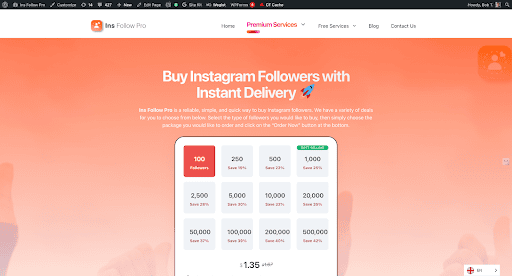
This Content is Sponsored by AccessiBe.
Creating a welcoming and accessible online store is vital in today’s diverse digital marketplace. This journey involves more than just implementing basic accessibility features; it’s about designing a space where every visitor, regardless of their ability or disability, can effortlessly browse, understand, and engage with your website. That is why companies like accessiBe are at the forefront of this movement and develop web accessibility solutions for businesses looking to support this paramount issue.
From intuitive site navigation to ongoing accessibility enhancements, we’ll delve into what it takes to forge an online shopping environment that is not just accessible but also engaging and inclusive for a broad spectrum of users.
Navigational Accessibility in Online Stores
A key aspect of any accessible e-commerce site is its navigability, especially for those who rely on alternative methods to the traditional mouse or touchscreen. A well-designed navigational structure is pivotal for customer satisfaction in online shopping. Elements to enhance navigational accessibility include:
Keyboard-Friendly Interface: This feature enables users to traverse the website using keyboard commands, a necessity for those who cannot use a standard mouse.
Intuitive Menu Design: Clearly defined and structured menus aid in guiding users through the site, ensuring a smooth browsing experience.
Uniform Site Layout: A consistent and predictable layout helps users, particularly with cognitive impairments, to navigate the site with confidence.
By focusing on these navigational aspects, online retailers can make their e-commerce platforms accessible and user-friendly, catering to a diverse customer base with varied browsing habits and needs.
Enhancing Web Accessibility Through Visual Customization
Adaptable visual settings play a critical role in web accessibility, particularly for e-commerce sites where the visual presentation significantly impacts the shopping experience. Essential features that enable visual customization include:
Adjustable Font Sizes: Providing users the option to change font sizes ensures better legibility for those with visual impairments.
High Contrast Viewing Modes: These modes cater to users with color vision deficiencies, making site navigation and content comprehension easier.
Audio Narration of Text: This feature transforms written content into spoken words, benefiting users with visual impairments or those who prefer auditory learning.
Implementing these visual customization options allows users to tailor their viewing experience to their preferences and needs, thereby enhancing the accessibility and usability of the online shopping platform. It’s a step forward in creating a site that’s not only accessible but also adaptable to a diverse range of visual requirements.
Simplifying Content for Better Accessibility
The simplicity and clarity of website content are vital for an accessible e-commerce experience. It’s crucial to present information in a way that is straightforward and easily navigable for all users, including those with specific accessibility needs. Focus areas to enhance content clarity and readability include:
Use of Clear, Concise Language: Simplified language aids in making content more accessible, especially for those with cognitive disabilities or those who are non-native language speakers.
Descriptive Alt Text for Visuals: Providing alt text for images is essential, as it allows users who rely on screen readers or cannot view images to receive the information conveyed visually.
Organized and Descriptive Headings: These help users navigate the site more effortlessly, enabling them to find relevant information quickly.
Prioritizing these content-focused features can significantly enhance a website’s accessibility. It ensures that all users, irrespective of their abilities, can effectively access and understand the site’s content. This approach not only improves the user experience but also extends the website’s reach to a wider and more diverse audience.
Aligning with Assistive Technologies for Enhanced Access
Compatibility with various assistive technologies is a critical component of accessible web design, particularly for online retail sites. Ensuring that your website functions seamlessly with different assistive devices and software is key to inclusive customer experience. Essential elements for achieving this compatibility include:
Standards-Compliant Web Development: Employing well-structured HTML and CSS coding ensures that assistive technologies can interpret and present the site’s content accurately.
Implementation of ARIA Attributes: Using Accessible Rich Internet Applications (ARIA) attributes provides essential context to assistive tools, aiding users in understanding the functionality of web elements.
By integrating these technological considerations, online retailers can improve the accessibility of their sites. This not only supports users who rely on assistive technologies but also fosters a more inclusive and navigable digital environment. Ensuring universal access to your website is fundamental in serving a diverse customer base and reinforcing the brand’s dedication to inclusivity.
Adapting to Varied Devices for Accessible E-Commerce
In the modern online shopping environment, it’s crucial for websites to be adaptable and responsive to various devices. This adaptability is a key factor in ensuring web accessibility, as customers may use anything from smartphones to laptops to access online stores. Elements that contribute to a website’s responsive and adaptive design include:
Adaptive Layouts: These layouts allow the website to adjust its content and structure according to different screen sizes, ensuring a seamless experience on any device.
Scalable Images: Ensuring that images scale appropriately across different devices enhances the visual aspect of the website, making it more accessible and appealing.
By focusing on these design principles, e-commerce platforms can provide an accessible and consistent shopping experience across a range of devices. This adaptability not only benefits users by offering a more user-friendly interface but also positions the online retailer as a versatile and customer-centric brand.
Accessible Multimedia in Online Retail
Integrating accessible multimedia content is crucial for creating a fully inclusive online shopping experience. Videos, audio clips, and other multimedia elements can greatly enhance user engagement if made accessible to all users, including those with disabilities. Important features for accessible multimedia include:
Video Subtitles: Subtitles are indispensable for users who are deaf or hard of hearing, allowing them to access audio information in videos.
Audio Descriptions: Providing detailed descriptions of visual information in videos supports users who are blind or visually impaired.
Including these accessible features ensures that all customers can enjoy the full range of multimedia content available on an e-commerce site. This not only broadens the audience reach but also demonstrates a commitment to inclusivity, enhancing the reputation of the online retailer as a brand that values all its customers.
Streamlining User Interactions on E-Commerce Sites
Streamlining user interactions on an e-commerce website is essential for creating an accessible and enjoyable shopping experience. This means ensuring that all elements, from clickable buttons to online forms, are designed with all users in mind. Key areas to enhance user interaction include:
Accessible Form Design: Forms should have clear, easy-to-understand labels and instructions, making them user-friendly for everyone, including those with disabilities.
Error Handling and Correction: Clearly identifying errors and providing straightforward correction methods improve the user experience, especially for those who may find navigating online forms challenging.
Identifiable Interactive Elements: Buttons, links, and other interactive features should be easily distinguishable and operable, catering to users who navigate using various methods and devices.
Focusing on these interaction elements enables online retailers to provide a smooth, efficient, and accessible shopping experience. This not only caters to a wider array of customers but also fosters a positive brand image by showcasing a commitment to inclusivity in digital commerce.
Upholding Ongoing Web Accessibility in E-Commerce
Maintaining consistent web accessibility is an ongoing process, particularly vital in the ever-evolving landscape of online retail. To ensure that e-commerce sites remain accessible and up to date, continuous maintenance is essential. Practices for sustaining accessibility include:
Periodic Accessibility Reviews: Regularly assessing the website to identify and address any emerging accessibility issues ensures continuous compliance with best practices.
Acting on User Feedback: Encouraging feedback from all users, especially those with disabilities, and using it to make informed improvements, keeps the site attuned to diverse user needs.
By engaging in these ongoing practices, online retailers can guarantee that their websites consistently meet accessibility standards. This dedication not only enhances the user experience for all customers but also signifies the retailer’s commitment to creating an inclusive and welcoming digital environment.
Fostering Inclusion in Digital Commerce Today
To wrap up, creating an accessible e-commerce platform involves more than just adhering to technical standards; it’s about crafting an environment where every customer, regardless of their unique needs and preferences, can engage comfortably and efficiently. Embracing the elements of user-friendly navigation, visual customization, clear content, assistive technology alignment, responsive design, accessible multimedia, streamlined interactions, and continuous maintenance transforms a standard online store into an inclusive shopping haven.
As online retailers integrate these vital accessibility features, they not only widen their market reach but also champion the cause of digital inclusivity. Remember, in the realm of online retail, accessibility is not just a courtesy – it’s the cornerstone of a customer-centric and forward-thinking business approach.


